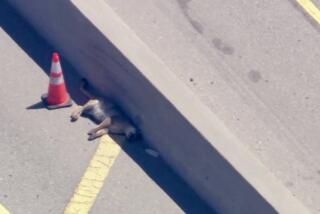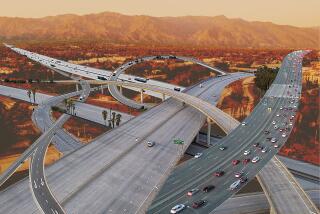Mixed signals from road markings
“The lines on the road just look like dots,” sang Commander Cody in the 1970s tune “Hot Rod Lincoln,” about a race up the Grapevine Hill.
At any normal speed, the white dashed lines on a road don’t look like dots, but a lot of motorists are still confused about what different road markings mean.
Road lines are supposed to control traffic in precise ways and convey exact legal requirements. But sometimes the engineers who design these road lines, technically known as control devices, and the authorities who police them operate in a different universe than motorists.
“We go to great pains to make the system as uniform as possible,” said Gerson Alexander, a former human factors chief at the U.S. Department of Transportation’s Federal Highway Administration.
Street and highway departments across the nation can design their own lines but are encouraged to apply federal standards. The standards come from the Manual on Uniform Traffic Control Devices, compiled by a committee of state and federal highway officials.
In a lot of cases, the lines are so obvious that nobody could possibly get confused. Dashed white lines are the lanes that vehicles are supposed to stay inside. And you can’t legally pass a vehicle when a double yellow line divides the road.
But matters get a little murky when it comes to single solid white lines and even more confusing when it comes to double solid white lines. A look around Southern California will turn up other unusual markings, such as quadruple yellow lines, diagonal yellow lines and sometimes black lines next to yellow lines.
A lot of motorists mistakenly believe, for example, that it is illegal to cross a single solid wide white line, typically used to mark an entrance lane or exit lane on a freeway. They are also used on bridges and approaches to major intersections.
In fact, the marking is meant to discourage -- but not prohibit -- motorists from making lane changes, said Lt. Maryann Farmar, a California Highway Patrol officer. “You can legally cross that single white line,” she said. “There is no violation in the vehicle code for crossing a single white line.”
But what about a double white line? Farmar and Alexander both say they have never seen a double white line. At least one place that has such markings is Long Beach, where deputies have handed out tickets at the airport to motorists for crossing double white markings.
Most people know you can’t cross a double yellow line to pass another vehicle on a two-lane road, and most know that you can legally make a left turn across a double yellow.
Turn pockets with yellow lines can be a little trickier. Most turn pockets are marked by two single yellow lines, but occasionally they are marked by two sets of double yellow lines. A turn across this kind of pocket can earn a motorist a ticket.
In general, white lines are meant to control traffic going in the same direction, while yellow lines are meant to control traffic going in opposite directions. But that system falls apart when it comes to carpool lanes, which are normally marked by double yellow lines to separate traffic going in the same direction.
In some cases, the California Department of Transportation has marked carpool lanes with quadruple yellow lines. Alexander said the federal manual has no provision for four parallel lines together, and a check on the Federal Highway Administration website showed that no experimental permit was ever issued for such a control device. Caltrans officials could not explain how the four-line arrangement came about.
A set of such lines noted on an Orange County freeway recently appeared intended to add extra separation between the carpool lanes and the rest of the road. For good measure, the engineers had added a solid white line next to the four yellow lines. Farmar said she believes that crossing four lines is the same kind of carpool-lane violation as crossing two lines. Alexander said federal officials try to discourage such devices.
“When a jurisdiction has a great idea and creates a traffic control device nobody has ever seen before, there are people who just won’t understand it,” he said. “The government goes through an extensive research process before any new control devices are used.”
Ralph Vartabedian can be reached at ralph.vartabedian@latimes.com.
More to Read
Sign up for Essential California
The most important California stories and recommendations in your inbox every morning.
You may occasionally receive promotional content from the Los Angeles Times.











